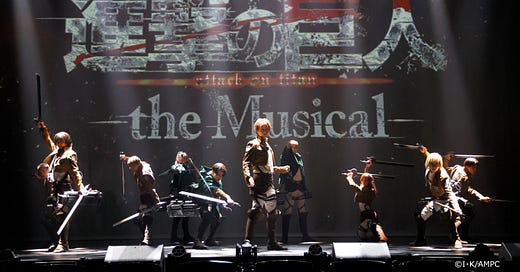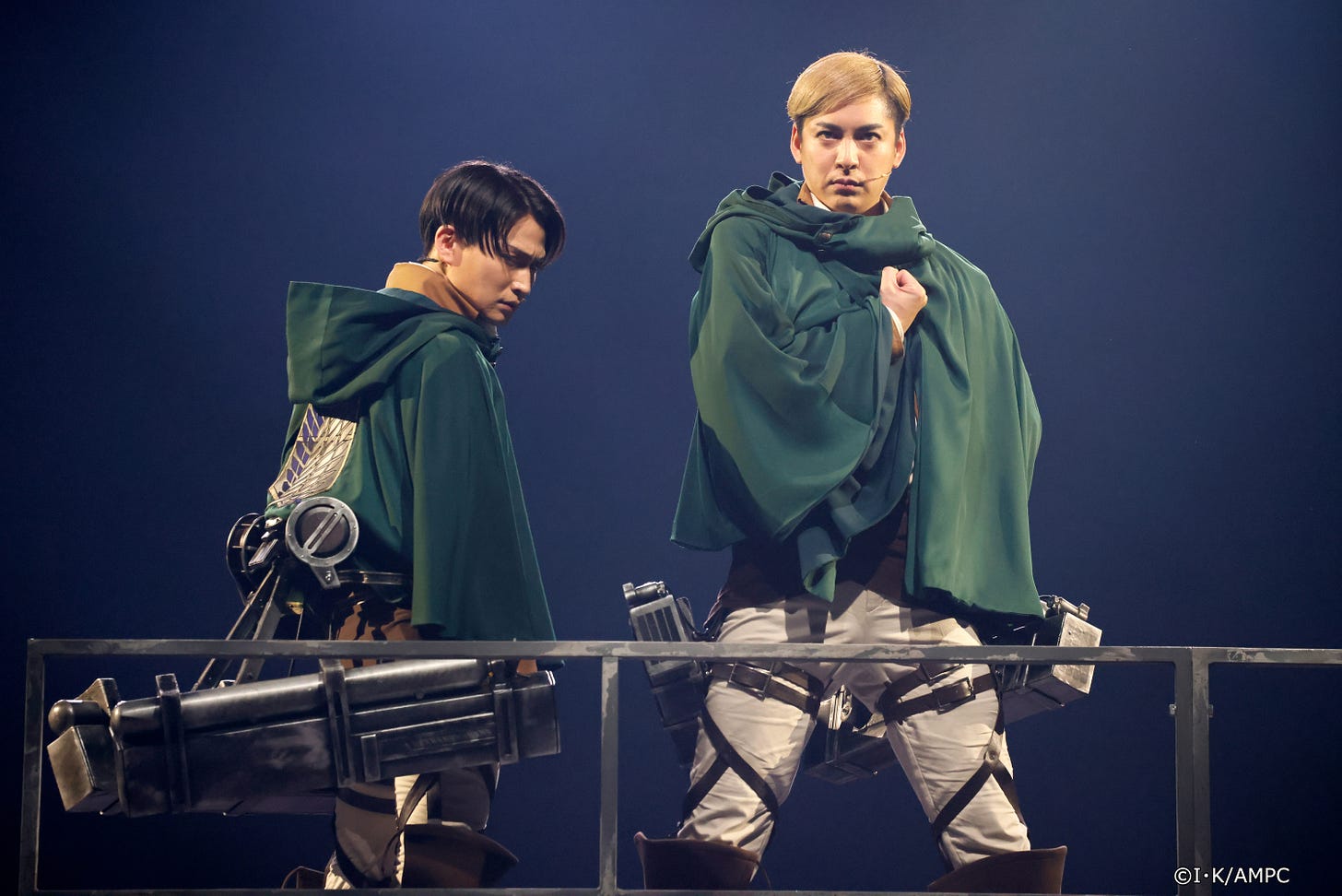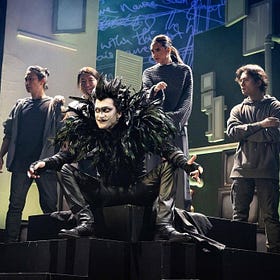MEET JAPAN'S $175 MILLION MUSICAL THEATER SUBGENRE
2.5D Musicals are huge in Tokyo—and with the New York run of Attack on Titan, they've set out to conquer the world.
A desolate post-apocalyptic landscape. Marauding, man-eating giants. The last remnants of humanity, huddled behind massive walls. A mother’s gruesome death, and the grieving son who vows to rid the world of those marauding Titans once and for all.
By Broadway standards, the plot of Attack on Titan: The Musical is pretty wild. But it’s actually kinda par for the course for 2.5D Musicals, the booming Japanese stage genre that’s seen
magical girls save the universe from evil (Pretty Guardian Sailor Moon The Super Live)
hunters with extraordinary powers track down fantastical creatures and treasures (Hunter x Hunter), and
two superfans try to solve their pop idol’s murder after being reincarnated into the bodies of the star’s two children (Oshi no Ko).
Original, Japanese-language musicals based on anime, manga and videogames—collectively dubbed 2.5D Musicals—are the hottest trend in the Tokyo musical market, exploding in popularity in the last decade and surging to even greater heights post-lockdown. In 2022, 2.5D Musicals raked in $175 million (¥26.2 billion) at the Japanese box office, or a whopping 40% of the nation’s total musical theater sales for the year.
Meanwhile, the last few years have brought London stage adaptations of anime and manga titles Spirited Away, My Neighbor Totoro, Death Note and Your Lie in April. Those U.K. runs have proven a mixture of promise and disappointment—but in a world where Japanese anime, manga and videogames regularly achieve massive popularity across borders, it’s not much of a leap to believe that their spinoff musicals might eventually find a similar fanbase around the globe.
That’s what the creators and producers behind 2.5D Musicals hope, anyway. With the New York run of Attack on Titan: The Musical, their hypothesis gets its latest test-run.
Welcome back to the full Jaques, your weekly guide to the global theater industry. After a hiatus, SPOTLIGHT STORIES have returned and paid subscriptions have resumed.
New to Jaques? Check out this handy explainer, and if you’re looking for the latest edition of ABROAD/WAY BULLETPOINTS, my regular round-up of international theater headlines, it’s thisaway.
With a Japanese cast of 35, an original score, and an elaborate production with projections, puppetry and wire work, Attack on Titan, based on the globally popular manga and anime, arrives at New York City Center this week after drawing crowds in Osaka and Tokyo last year. This initial U.S. engagement may be brief—four performances over three days (Oct. 11-13), prior to return engagements in Tokyo and Osaka—but it just might offer an indicator of the potential for these Japanese juggernauts to find fame on U.S. stages and beyond.
In this SPOTLIGHT STORY, I’ll highlight
interviews and insights with the producers of Attack on Titan and the founder of the 2.5D Musical Association,
the latest data from the Japanese market underscoring the standout box office power of 2.5D Musicals,
why some in the local theater industry look down their noses at 2.5D Musicals despite their popularity, and
the steps theatermakers are taking to make 2.5D Musical a global phenom.
Say konnichiwa to the musical genre that just might be coming soon to a theater near you.
OKAY BUT WHAT’S UP WITH THAT NAME?
If you’re hearing it for the first time, the term “2.5D Musical” might sound like a neg: What, like your show isn’t as fully dimensional as traditional stage musicals that are live and in person and take place in all three dimensions?
But it’s a name initially coined by fans and embraced by the creators and producers themselves as a way of wearing their popular source material on their sleeves, and as a mark of fidelity to their roots—which are a source of pride for many Japanese creators.
“2.5-dimensional musicals are uniquely Japanese, original musicals based on manga, anime, and videogames, which are the shining stars of Japanese culture,” says Makoto Matsuda, the CEO of Nelke Planning Co., Ltd., one of the production companies behind Attack on Titan: The Musical. A decade ago, Matsuda founded the Japan 2.5-Dimensional Musical Association.
Back then, Matsuda recalls, “the number of the 2.5-dimensional musicals were on the rise. But without an organized effort, I felt that it would end as a temporary trend. To establish it as a genre both nationally and internationally, I felt it was imperative that there be a united front to represent such productions happening all over Japan.”
Now the Association acts as a kind of brand ambassador, offering support for promotional activities, government and international relations, and marketing, while the organization’s website serves as a consumer guide and ticketing platform for the 2.5D Musicals now playing in Tokyo and beyond.
But in the face of the genre’s growing popularity, I encountered something of a snob factor in my conversations with folks in the broader Japanese theater industry. While everyone acknowledges 2.5D Musicals as an economic force, some dismiss them on artistic terms, believing it’s a form that slavishly matches its two-dimensional inspirations and places primary importance on whether an actor looks the part, not on their skills as a performer.
“It’s two totally different aesthetics,” one Tokyo theater exec told me, not without a whiff of condescension.
Those differences in perception lead to some ambiguity regarding what exactly qualifies as a 2.5D Musical. For instance: During my visit to Seoul earlier this year for the K-Musical Market, a presentation by Nahoko Yamazaki, an executive at the major Tokyo production company Toho, classified the Japanese musicals Spy x Family, The Ghost and the Lady, and Death Note—all based on popular manga and/or anime—as “original musicals,” an entirely separate category from the 2.5D Musicals listed like Prince of Tennis and Touken Ranbu.
Similarly, you can bet that the makers of Spirited Away (produced by Toho) and My Neighbor Totoro (from the Royal Shakespeare Company and Nippon TV) wouldn’t call their shows 2.5D Musicals, despite their Studio Ghibli source material.
Disambiguation difficulties aside, the recent London run of Spirited Away, and the upcoming return engagement of Totoro in the West End, still represent a major profile boost in the English-speaking world for musicals based on anime and manga, regardless of whether those shows embrace the 2.5D Musical label.
And snob factor or no, 2.5D Musicals are more popular than ever—and after lockdown, they’ve bounced back even more robustly than Japan’s musical theater market as a whole. Just take a look at the data.
JAPAN’S MUSICAL MARKET IS ON A POST-COVID RISE
According to the figures compiled by Japan’s PIA Research Institute, musical theater (like the rest of the nation’s live entertainment business) rebounded big in 2021:
TOTAL MUSICAL BOX OFFICE
2020: ¥19.7 billion (~$132 million)
2021: ¥60.3 billion (~$405 million)
2022: ¥64.3 billion (~$432 million)
MUSICAL ATTENDANCE
2020: 2.34 million
2021: 6.75 million
2022: 7.21 million
Like on Broadway, full recovery is slower than hoped and neither box office nor attendance have yet hit the highs of 2019, when sales came in at ¥78.7 billion (~$533 million) from 9.3 million theatergoers.
BUT 2.5D MUSICALS ARE HITTING ALL-TIME HIGHS
If you break out the numbers for 2.5 Musicals alone (as PIA did), you’ll see the genre keeps topping itself:
2.5D MUSICAL BOX OFFICE
2020: ¥7.7 billion (~$52 million)
2021: ¥23.9 billion (~$161 million)
2022: ¥26.2 billion (~$176 million)
2.5D MUSICAL ATTENDANCE
2020: 880,000
2021: 2.34 million
2022: 2.74 million
Box office for 2.5D Musicals set a new record in 2021 and then bested itself again in 2022. The previous sales record of ¥22.6 billion (~$153 million) had been achieved in 2018, when attendance hit an all-time high of 2.78 million. That attendance record still stands, but 2022’s 2.74 million has come within spitting distance: “Many 2.5D fans have returned to theaters soon after the pandemic has subsided, supporting the industry,” says Matsuda.
In 2022, the average ticket price (ATP) paid for 2.5D Musicals was (slightly) higher than the ATP for musicals overall: ¥9,562 (~$64.50 ) for 2.5D Musicals vs. ¥8,918 (~$60) across all musicals. That year, total 2.5D Musicals sales accounted for 40% of Japan’s total musical sales.
The PIA Research Institute hasn’t yet released granular data for 2023, but the overall upward trend has continued: Recently the organization announced that in 2023, total ticket sales for live events (encompassing music in addition to theater) hit a new high of ¥685.7 billion (~$4.6 billion), a 21.3% bump up from 2022 and an 8.9% rise compared to 2019’s pre-pandemic peak.
A MUSICAL THEATER GENRE WITH HISTORY
For 2.5D Musicals, the data from PIA charts a rapid rise that the pandemic hardly slowed, with the total sales for 2022, ¥26.2 billion (~$176 million), continuing a steep upward trend from the ¥8.7 billion (~$58.7 million) recorded in 2013 (the earliest numbers available). And the history of the form, in all its variations, stretches back even further than that:
1974
In a successful bid to boost its flagging attendance, Japan’s well-known, all-female troupe Takarazuka Revue premieres The Rose of Versailles, largely considered the first stage musical based on a popular manga
2000
After an intermittent string of early “anime musicals” like Saint Seiya: Knights of the Zodiac, the first 2.5D Musical to become a hit is Hunter x Hunter, in which the voice actors for the animated film reprised their roles onstage
2003
Widely considered the show that launched the subgenre into popularity and prominence, Musical The Prince of Tennis (familiarly abbreviated as Tenimyu) premieres and develops into a long-running series of musicals that are still going today
2008
Tenimyu plays South Korea and Taiwan, marking the first Asian tour for a 2.5D Musical
2014
Tenimyu producer Makoto Matsuda founds the 2.5-Dimensional Musical Association
2015
A venue dedicated to 2.5D Musicals, AiiA 2.5 Theater Tokyo, opens in Tokyo’s Shibuya neighborhood
Western talent gets into the musicals-based-on-manga game when Death Note, with music by Frank Wildhorn, premieres in Tokyo
Kabuki adaptations of anime and manga titles, including One Piece and Naruto, become increasingly common
2018
Pretty Guardian Sailor Moon The Super Live has its European premiere in Paris
2019
Pretty Guardian Sailor Moon plays the U.S. with stops in New York City and Washington, D.C.
2022
Spirited Away, directed by Les Misérables architect John Caird, premieres in Tokyo
Another high-profile Studio Ghibli title, My Neighbor Totoro, gets an English-language world premiere at London’s Barbican
2023
Death Note plays an English-language, West End concert run in London that proves so popular it moves theaters and extends twice
2024
A 12-week West End run of Your Lie in April, a Wildhorn musical based on an anime and manga hit, closes early
Spirited Away has its U.K. premiere (in Japanese with English supertitles) in a summer run at the London Coliseum
Attack on Titan: The Musical makes its U.S. debut at New York City Center
ATTACK ON NEW YORK
For the 2.5D Musicals Association, those French and U.S. stagings of Sailor Moon in 2018 and 2019 represented the first steps in an international push that’s now picking up again in the wake of COVID. “When we were ready to finally put full force into launching globally, the pandemic happened,” Matsuda recalls.
After a lockdown pivot to stream a handful of popular 2.5D Musical titles to global audiences, the transnational travels resume with Attack on Titan.
For the backers of the show, Attack on Titan seems the perfect candidate to find success abroad. “Several factors suggest a strong audience for a 2.5D Musical like Attack on Titan,” says Kumiko Yoshii, the U.S. producer of the show. “The global popularity of anime and manga, with its large and engaged fanbase, creates a solid foundation.”
You can see her point: The manga sales for Attack on Titan alone hit 140 million copies, and in 2023-24, the anime was the most popular in the world, according to Parrot Analytics.
Plus, Yoshii adds, “Past successes of similar productions”—like Sailor Moon, which sold out its three-performance run in 2019 at what was then called the PlayStation Theater in New York—“demonstrate an appetite for this genre in the U.S. and worldwide. Additionally, New York’s reputation for embracing innovative theater”—see: the production’s multimedia mix of projection, puppets and wire work—“and the growing integration of Japanese media into Western culture support the potential success of such a show.”
REPLICATION VS. REINVENTION
The creative team of Attack on Titan includes a number of 2.5D Musical veterans, including book writer Masafumi Hata (Blue Period); director Go Ueki (Hypnosis Mic -Division Rap Battle- Rule the Stage); and lyricist Kaori Miura, who has written and directed stage installments of Tenmiyu and Sailor Moon. Rap artist Ken the 390 writes the music.
In taking Attack on Titan to the stage, the collaborators faced the challenge confronted by a lot of stage musicals adapted from long-running, serialized manga: how to condense an epic story into a single, satisfying evening at the theater. In its original comic form, Attack on Titan ran for 12 years and filled 34 volumes; the anime stretches across 94 episodes.
“We’ve chosen to adapt the opening of the story, which is most crucial for this saga,” say Japanese producers Michiho Matsumoto (of Nelke Planning Co., Ltd.) and Rie Yoneda (of S-SIZE inc.) in written answers to questions I sent them. “Rather than condensing the story, we took time with each scene and each dialogue so as not to betray the expectations of the original manga fans.”
And that’s where 2.5D Musicals seem to differ most from the musical adaptations that dominate Broadway and the West End. Every musical based on beloved IP must strike a balance between replication and reinvention, but for 2.5D Musicals, the weight of fan expectations generally tips the scales toward replication.
You see that tug-of-war play out from an actor’s point of view in a recent interview with Takuro Ohno, whose role in Attack on Titan is his first in a 2.5D Musical. In other shows, he says, he’s felt free to bring his own interpretation to a character, even if he’s playing a historical figure.
“In the case of 2.5D musicals, it’s different,” he tells Entertainment OVO (via Google Translate). “The character’s shape is drawn in the manga, and the way the character speaks is also shown, and since this work is also an anime, for example, the changes in facial expressions are more precisely embodied in the anime. The fans already have a solid image of the character in their minds. Since I was trying to portray it in three dimensions, I think it was a bit like imitation, and that was the difficulty.”
The show’s collaborators do want to innovate, however, when it comes to the production’s technology and the novel use of spectacle-oriented stage techniques. “We’ve also used visual media and physical expressions of the dancers called ‘Blade Attackers’ to portray the Titans, and the emotions and battles are conveyed through wire actions and dance,” Matsumoto and Yoneda note.
Attack on Titan comes to New York in its original Japanese language iteration because, its producers say, the fans demanded it. “The enthusiastic U.S. fanbase indicates a strong desire to experience the production in its original form,” Yoshii says. “This approach could lead to more 2.5D Musicals being introduced in the U.S., potentially resulting in longer runs and greater recognition.”
THE QUESTION OF STAYING POWER
If you’re in New York hoping for a last-minute ticket to Attack on Titan, you’d better be prepared to pony up. The last time I checked, only a handful of tickets were available for each of the show’s four performances, and most of them were in the primo $400 tier. (The rest were partial view.)
Of course, it’s one thing to succeed with a limited run of a few performances, but it’s another thing entirely to draw the kind of crowds that warrant an extended stay.
Inasmuch as the reception of any prior show can predict the trajectory for another, the tea leaves for musicals based on anime and manga are mixed for the English-speaking market. Sure, Your Lie in April disappointed in the West End with its curtailed run, but My Neighbor Totoro proved a big enough hit to spur a West End return in 2025 with an initial on-sale period of 34 weeks. And it’s no secret that New York and the U.S. seem the next logical frontier for shows like Spirited Away, Totoro and Death Note.
Back in Japan, the 2.5D Musical Association has begun to promote the form to the rising tide of tourists that has hit Japan in the pandemic’s wake. The association’s website, for instance, aims to smooth over any consumer language gaps with a English-language ticketing page.
Meanwhile, international stagings of 2.5D Musicals bring all the usual challenges of producing across borders, including the shipment of set components and the securing of visa for, in the case of Attack on Titan, a cast of 35 and a backstage staff of 30.
But spurred by success at home, Japan’s producers of 2.5D Musicals see nothing but opportunity abroad.
“We hope to increase the number of 2.5-dimensional shows offered internationally,” Matsuda says. “We also aim to make 2.5-dimensional shows one of the evening entertainment options for anyone who visits Tokyo from outside of Japan. I hope that eventually, there will be a day when 2.5-dimensional shows based on Japanese manga, anime, and videogames are performed all over the world.”
FURTHER READING
Manga adaptations were a big part of my wide-ranging conversation with the busy international composer Frank Wildhorn:
THIS MANGA IS A FRANK WILDHORN MUSICAL
While he was away from Broadway, this American composer became one of the most popular theater creatives in the world. Now he's readying his return to New York and London.
And I caught the Korean production of Your Lie in April when I was in Seoul earlier this year:
SEOUL SNAPSHOT
As the Korean wave hits Broadway, I spent two weeks in Seoul getting to know the local market. Here are the 7 biggest takeaways from my trip.







